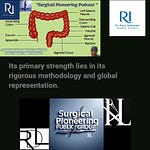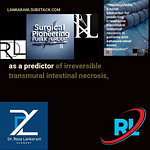"Surgical Pioneering
Surgical Frontiers: Pioneering Tech Transforming Surgical Care"
Mission Statement:
Welcome to Surgical Frontiers, a global nexus for surgeons, researchers, engineers, and healthcare innovators dedicated to advancing surgical care through groundbreaking technology. This group is not just a platform—it’s a movement. Here, we explore, debate, and champion the innovations redefining the art and science of surgery. From AI-driven diagnostics to robotic-assisted procedures, augmented reality (AR) surgical navigation, and bioengineered implants, we are the vanguard of a new era in medicine. If you’re driven by curiosity, excellence, and the relentless pursuit of better patient outcomes, you belong here.
---
Our Core Values:
1. Innovation First
Surgery is no longer confined to scalpels and sutures—it’s a fusion of biology, engineering, and data science. We prioritize discussions on emerging technologies (e.g., nanorobotics, AI-powered predictive analytics, 3D bioprinting) and their real-world applications. Share prototypes, clinical trial results, or even bold hypotheses—if it pushes boundaries, we want to hear it.
2. Collaboration Over Competition
Breakthroughs happen when diverse minds unite. Surgeons, engineers, ethicists, and entrepreneurs are all equal stakeholders here. Whether you’re a seasoned robotic surgeon or a startup founder developing smart OR tools, your perspective matters. Let’s dismantle silos and co-create solutions.
3. Evidence-Based Excellence
Pioneering doesn’t mean reckless. We demand rigor. Posts about new tools or techniques should be grounded in peer-reviewed research, clinical data, or transparent case studies. Anecdotes are welcome, but they must spark deeper inquiry, not replace it.
4. Patient-Centric Ethics
Technology is a means, not an end. Every innovation must answer: How does this improve patient safety, accessibility, or outcomes? We encourage tough conversations about cost, equity, and unintended consequences. Glorifying "tech for tech’s sake" has no place here.
5. Global Perspective
Surgical challenges vary wildly between a high-resource urban hospital and a rural clinic. Share insights from low-income regions, disaster zones, or underserved communities. Innovation thrives when we solve for the margins, not just the mainstream.
---
What You’ll Find Here :
- Breakthrough Technologies: Deep dives into robotics, AI/ML applications, AR/VR surgical training, IoT-enabled devices, and beyond.
- Expert Insights: Q&As with thought leaders, interviews with FDA regulators, and AMAs (Ask Me Anything) with pioneers.
- Case Studies: How a hospital in Kenya adopted portable robotic tools, or how a Boston team used AI to reduce post-op infections by 40%.
- Ethical Debates: Should AI diagnose surgical complications? Who owns data from smart implants?
- Resource Sharing: Grants, conferences (e.g., SAGES, AACR), and regulatory updates.
---
Why Join?
- Learn: Weekly summaries of JAMA Surgery or Annals of Surgery highlights.
- Influence: Shape the future by beta-testing tools, joining global consortia, or advising startups.
- Grow: Mentorship threads for residents, grants for underrepresented innovators, and hackathons.
---
The Future We’re Building:
Imagine a world where:
- A surgeon in Mumbai receives real-time AR guidance from a specialist in Toronto.
- Bioprinted organs eliminate transplant waitlists.
- AI predicts surgical complications before the first incision.
"This isn’t science fiction—it’s the horizon we’re sprinting toward."
Let’s pioneer responsibly. Let’s operate fearlessly. Post, comment, and collaborate. The next surgical revolution starts here.
—
Reza Lankarani M.D
Founder & Curator, Surgical Frontiers
"Surgical Pioneering
Surgical Frontiers: Pioneering Tech Transforming Surgical Care"
"Surgical Pioneering
Surgical Frontiers: Pioneering Tech Transforming Surgical Care"
Mission Statement:
Welcome to Surgical Frontiers, a global nexus for surgeons, researchers, engineers, and healthcare innovators dedicated to advancing surgical care through groundbreaking technology. This group is not just a platform—it’s a movement. Here, we explore, debate, and champion the innovations redefining the art and science of surgery. From AI-driven diagnostics to robotic-assisted procedures, augmented reality (AR) surgical navigation, and bioengineered implants, we are the vanguard of a new era in medicine. If you’re driven by curiosity, excellence, and the relentless pursuit of better patient outcomes, you belong here.
---
Our Core Values:
1. Innovation First
Surgery is no longer confined to scalpels and sutures—it’s a fusion of biology, engineering, and data science. We prioritize discussions on emerging technologies (e.g., nanorobotics, AI-powered predictive analytics, 3D bioprinting) and their real-world applications. Share prototypes, clinical trial results, or even bold hypotheses—if it pushes boundaries, we want to hear it.
2. Collaboration Over Competition
Breakthroughs happen when diverse minds unite. Surgeons, engineers, ethicists, and entrepreneurs are all equal stakeholders here. Whether you’re a seasoned robotic surgeon or a startup founder developing smart OR tools, your perspective matters. Let’s dismantle silos and co-create solutions.
3. Evidence-Based Excellence
Pioneering doesn’t mean reckless. We demand rigor. Posts about new tools or techniques should be grounded in peer-reviewed research, clinical data, or transparent case studies. Anecdotes are welcome, but they must spark deeper inquiry, not replace it.
4. Patient-Centric Ethics
Technology is a means, not an end. Every innovation must answer: How does this improve patient safety, accessibility, or outcomes? We encourage tough conversations about cost, equity, and unintended consequences. Glorifying "tech for tech’s sake" has no place here.
5. Global Perspective
Surgical challenges vary wildly between a high-resource urban hospital and a rural clinic. Share insights from low-income regions, disaster zones, or underserved communities. Innovation thrives when we solve for the margins, not just the mainstream.
---
What You’ll Find Here :
- Breakthrough Technologies: Deep dives into robotics, AI/ML applications, AR/VR surgical training, IoT-enabled devices, and beyond.
- Expert Insights: Q&As with thought leaders, interviews with FDA regulators, and AMAs (Ask Me Anything) with pioneers.
- Case Studies: How a hospital in Kenya adopted portable robotic tools, or how a Boston team used AI to reduce post-op infections by 40%.
- Ethical Debates: Should AI diagnose surgical complications? Who owns data from smart implants?
- Resource Sharing: Grants, conferences (e.g., SAGES, AACR), and regulatory updates.
---
Why Join?
- Learn: Weekly summaries of JAMA Surgery or Annals of Surgery highlights.
- Influence: Shape the future by beta-testing tools, joining global consortia, or advising startups.
- Grow: Mentorship threads for residents, grants for underrepresented innovators, and hackathons.
---
The Future We’re Building:
Imagine a world where:
- A surgeon in Mumbai receives real-time AR guidance from a specialist in Toronto.
- Bioprinted organs eliminate transplant waitlists.
- AI predicts surgical complications before the first incision.
"This isn’t science fiction—it’s the horizon we’re sprinting toward."
Let’s pioneer responsibly. Let’s operate fearlessly. Post, comment, and collaborate. The next surgical revolution starts here.
—
Reza Lankarani M.D
Founder & Curator, Surgical Frontiers
"Surgical Pioneering
Surgical Frontiers: Pioneering Tech Transforming Surgical Care"













Share this post